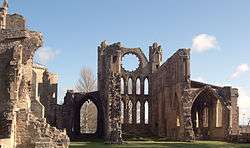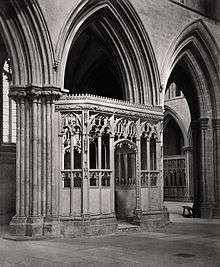Hospital chantry
A hospital chantry is a part of a hospital dedicated to prayer.


History
During the period 1100 to 1600 the western Latin Church developed a comprehensive theology of charity and what came to be known as Purgatory. In Scotland together with England and Wales, different traditions developed in the provision of care for the elderly, the sick and the dying.
In Scotland hospitals provided a number of functions: Travellers’ rest, care homes for elderly men and women; and sub-monastic prayer communities. Hospitals such as Bishop Dunbar’s Hospital in Old Aberdeen were in part prayer communities and in part care homes. Most hospitals or maison Dieu had a place or room set aside as a chantry chapel, or an oratory.[lower-alpha 1] In the Kincardine O’Neil Hospital, the situation on a drove road offered a travellers’ rest as well as a care and prayer community. Cowan et al.[1] provide details of some 165 hospitals that offered all or some of these functions. In England, similar conditions from the early to late medieval period applied.[2][3]
In addition to care for the elderly, the church in Scotland and England became dominated by what might be called a theology of care for the elderly,[lower-alpha 2] The theology and practice of purgatory came to dominate the church and the country as a whole.
Across the Western world charity and purgatory became the two themes that were often in conflict. Bedehouses and hospitals were founded to meet the requirements of charity and purgatory. In response to this theology individuals often made provision for their after-life by endowing priests and others to say what became known as the Requiem Mass.
The chantry became the place where such masses where said.[lower-alpha 3] Chantries owe their name and function of providing an endowment or place for the maintenance of priests to sing daily mass for the souls of founders.[5]
In some cases altars or chapels in churches were endowed in this fashion.[lower-alpha 4]
In Scotland Bishop Dunbar, in the months before he died in 1532, founded a "chantry" or chapel in Elgin Cathedral in memory of his father and mother. The mortification records his wishes and obligations as follows:
…in honorem Sanctse Trinitatis et fanctorum Columbae et Thomae martyris, et pro falute animarum Regis ejufque predeceflbrum et fucceflbrum, Alexandri Dunbar de Weftfeld militis et dominse Elizabethie Suthirland ejus fponfse…"[6]
Howard Colvin[7] provides a definitive account of the origins of chantries in England. Further evidence of their Anglo-Norman origins is provided by David Crouch.[8] Colvin summarizes the situation as follows:
… in origin the chantry can therefore be seen as the answer to what was essentially a monastic problem: how to continue effectively to intercede for an army of the dead whose ranks were already growing uncontrollably even before the official recognition of Purgatory had drawn fresh attention to their predicament. It was a privatised means of salvation devised to cope with an increasing demand for intercession with which the established monastic corporations could not cope … the chantry may well have satisfied, in a way acceptable to the Church, the deep-rooted desire for a religious establishment under private control which, in its grosser forms, had been stamped out by the reforms of the twelfth century. Its flexibility in terms both of endowment and of duration enabled it – unlike the monastic foundation – to be adapted to the means of all ranks of society, so that what had begun largely as a form of seigneurial piety came in time to be adopted by the new squirearchy of the later middle ages and by self-made men like wool-merchants, who could identify with a parish church in a way that they perhaps could not with an old-established monastery of royal or baronial foundation …
In general functions provided in chantries where they were separate establishments – e.g. Noseley, St Anne's Chapel in Barnstaple, Devon and Lincoln Cathedral were the same as those provided in many of the medieval hospitals and bedehouses in Scotland.[lower-alpha 5]
See also
Notes
- In Old Aberdeen, St Mary’s Hospital (Bishop Dunbar’s Hospital) had a "…a common room sixteen wide, and thirty-six feet long, for all the poor … and opposite to it, in the south side of the house, there will be an oratory well furnished and of the same size as the common room of the house, and provided with an altar…"
- The biblical teaching of charity provided a rationale for the care of the living; purgatory provided a rationale for the treatment of the dying and the dead.[4]
- In general chantries were largely found in England. The Abolition of Chantries Acts of 1545 and 1547 were an attempt to withdraw power and wealth from the Church.
- In some cases the term "obit" is used to describe services or offices for the souls of deceased persons at the request and often expense of families. "Obit" is sometimes recorded as "obiit" – Latin for "he/she/ it died".
- The term maison Dieu is also applied to these foundations. For example, Maison Dieu, Faversham.
References
- Cowan, Ian Borthwick; Easson, David Edward; Hadcock, Richard Neville (1976). Medieval Religious Houses, Scotland with an Appendix on the Houses in the Isle of Man (2nd ed.). London: Longman. pp. xxviii, 252p, [4] fold plates.
- Gasquet, Francis Aidan (1904). English Monastic Life.
- Godfrey, Walter H. (1955). The English Almshouse, with Some Account of Its Predecessor, the Medieval Hospital. London.
- Le Goff, Jacques (1984). The Birth of Purgatory. Scolar.
- See http://www.ewelmealmshousecharity.org/history.html for details of an important almshouse and chantry foundation.
- Bannatyne Club Registrum episcopatus Moraviensis e pluribus codicibus consarcinatum circa A.D. MCCC, cum continuatione diplomatum recentiorum usque ad A.D. MDCXXIII
- Colvin, H (2000). "The Origin of Chantries". Journal of Medieval History. 26: 163–173.
- Crouch, David (2001). "The Origin of Chantries: Some Further Anglo-Norman Evidence". Journal of Medieval History. 27: 159–180.